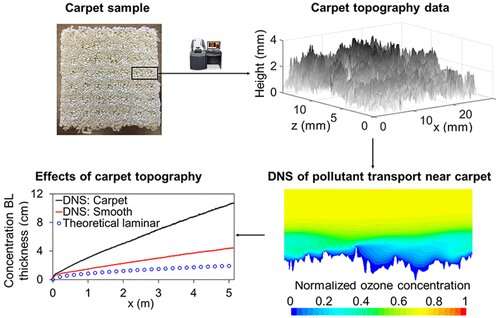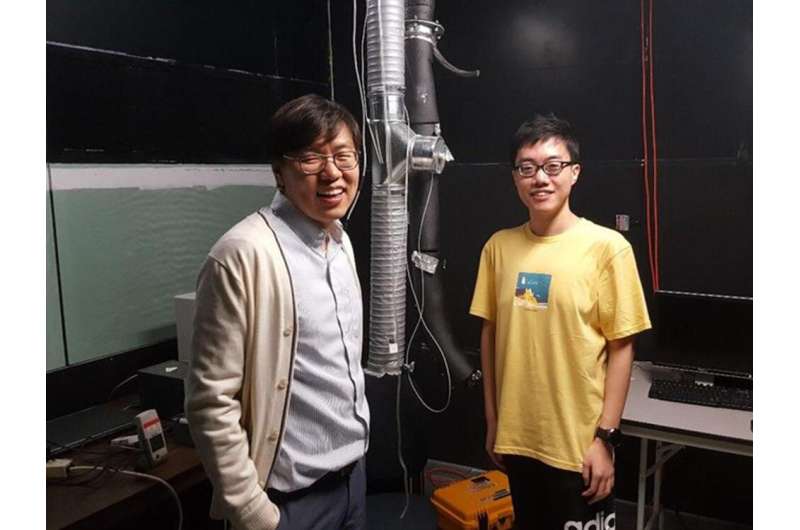Framework to study ozone levels on realistic indoor surfaces

A Penn State-led research collaboration set out to improve the understanding of indoor ozone concentrations by modeling how the pollutant interacts with common indoor surfaces.
Ground-level ozone, the pollutant in smog that adversely affects respiratory and circulatory health, isn't limited to the outdoors. The Environmental Protection Agency reports that indoor ozone concentrations can be as high as 80% of outdoor levels, but determining how bad indoor levels are is difficult.
Existing models that predict how ozone transfers from the air to indoor surfaces are primarily applied for ideal smooth surfaces. Information on this dynamic for irregular indoor surfaces, such as carpet, is limited. Donghyun Rim, associate professor of architectural engineering, and his team developed a new modeling framework to study ozone transfer based on realistic indoor surfaces and airflow conditions. Their approach has been published in Environmental Science and Technology.
Ozone travels indoors and is deposited onto rugs, walls, upholstery and other surfaces. The transported ozone initiates oxidation reactions on these surfaces, altering the chemical composition of indoor air and exposing humans to air toxins. When the increased concentrations of aldehydes and other harmful reaction byproducts are inhaled, they can cause several adverse health problems and sensory irritations.
The rate at which ozone travels from the room's air to indoor surfaces can impact the reactions they initiate. This rate is primarily governed by airflow conditions and ozone diffusion within the boundary layer of the surface, or where the surface touches the room's air.
By using microscopic scanning of the actual surfaces and simulating fluid dynamics of the ozone transfer, the team investigated how varying indoor surface topography, such as carpeting and textured walls, influences the way ozone transfers from the air.

"In indoor environments, few surfaces are ideally smooth," said Rim, who is also affiliated with the Penn State Institute for Computational and Data Sciences. "Indoor rough surfaces provide more sites available for pollutant reaction. A better understanding of the mechanisms underlying ozone interactions with common indoor surfaces can improve our prediction of human exposure to ozone and oxidation products."
The team found that indoor surface topography potentially modulates airflow characteristics, affecting the size of the ozone boundary layer near the surface and, as a result, how much ozone transfers to the surface. A carpet surface with irregular roughness could contribute to a much thicker boundary layer—as much as 140% larger—than a smooth surface under the same airspeed conditions, Rim said.
"This finding can help us better understand indoor pollutant-surface interactions depending on the actual surface topology, given that a thicker boundary layer results in larger time and space scales for physical transport and chemical reaction of pollutants," Rim said.
However, according to Rim, the intrinsically higher surface area of textured indoor surfaces, such as carpets, does not necessarily mean the ozone will settle into the increased number of sites to react and form more pollutants.
"Our study reveals that the effective surface area available for pollutant reaction varies with air speed and turbulent mixing within the surface boundary layer between the surface and the rest of the air," Rim said.
The researchers said their methodology could be applied to further investigate the relationship between indoor air speed and ozone transfer for other indoor surfaces, as well as to analyze how temperature gradient between surface and air may influence pollutant transfer to surfaces. They noted that their model could be further extended by incorporating the probability of surface reaction to examine how results vary with distinct surface types and ages, as well as with different pollutant species.
More information: Gen Pei et al, Understanding Ozone Transport and Deposition within Indoor Surface Boundary Layers, Environmental Science & Technology (2022). DOI: 10.1021/acs.est.1c08040
Journal information: Environmental Science and Technology , Environmental Science & Technology
Provided by Pennsylvania State University





















